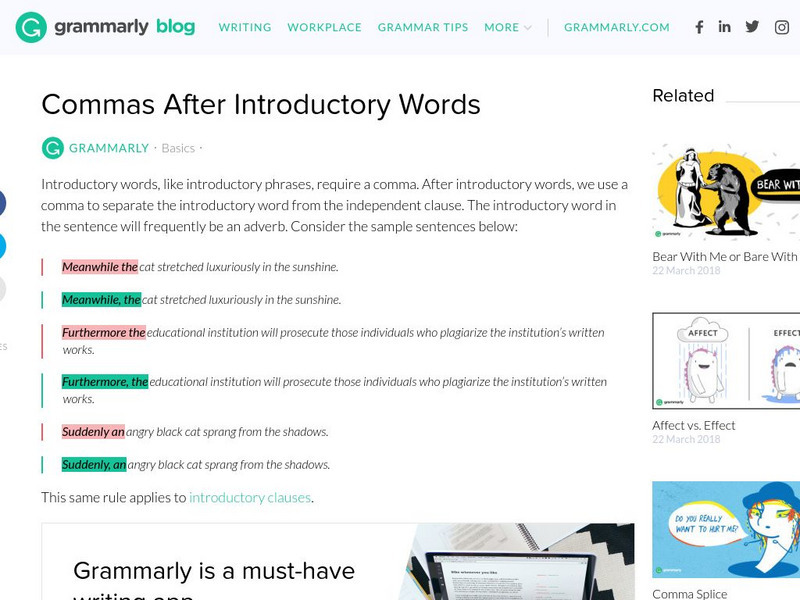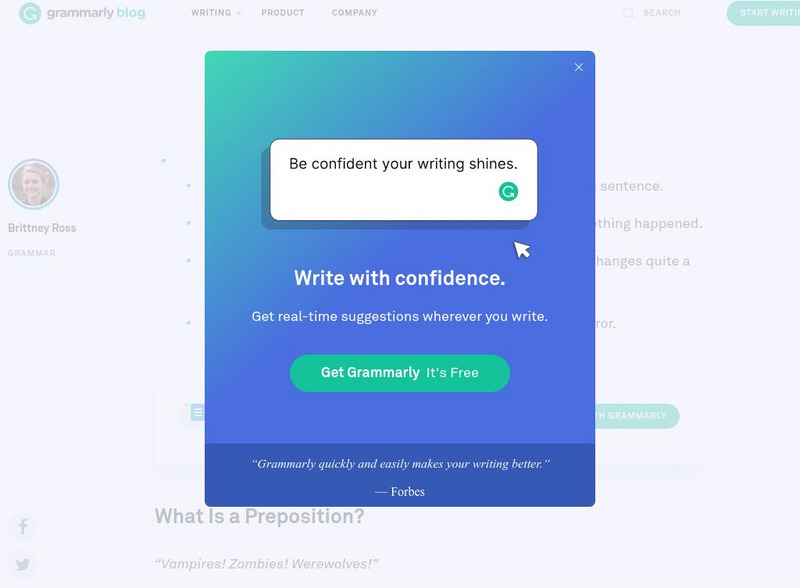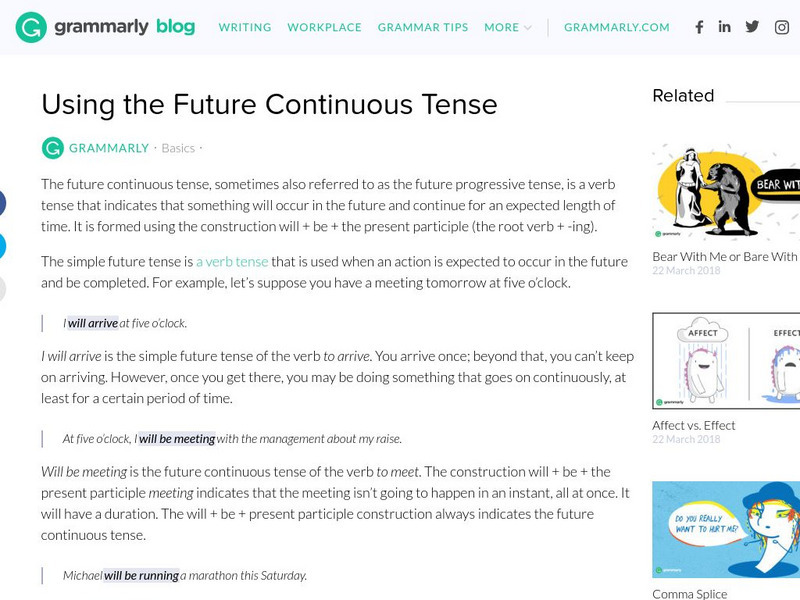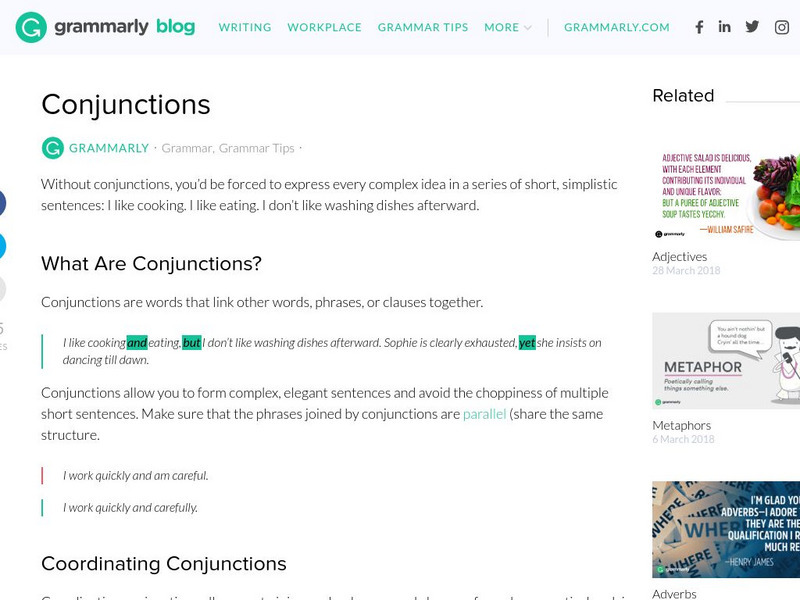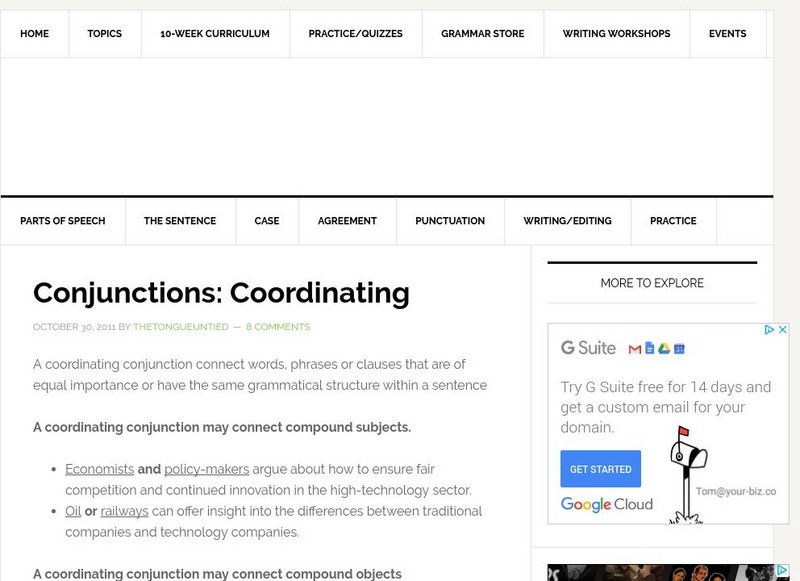Grammarly
Grammarly Blog: Commas After Introductory Words
This Grammarly Handbook resource explains how to use commas after introductory elements. Numerous examples of commas after introductory phrases, introductory clauses, and introductory transitions are provided in this resource.
Grammarly
Grammarly Blog: Parentheses and Brackets
Rules and examples for using parentheses and brackets correctly in sentences.
Grammarly
Grammarly Blog: Adjectives and Adverbs What's the Difference?
This blog article focuses on adjectives and adverbs including their purpose and the confusion between them. It offers links pertaining to adjective and adverb use and misuse.
Grammarly
Grammarly Blog: Uses of Prepositions
This page explains the uses of prepositions including to show direction, time, location, and spatial relationships. Examples are provided.
Grammarly
Grammarly Blog: Comma After Introductory Clauses
Rules and examples for using commas correctly with an introductory clause.
Grammarly
Grammarly Blog: Everyday vs. Every Day
This page provides the rules for the proper use of the words "everyday" and "every day."
Grammarly
Grammarly Blog: Verb Tense Consistency: Grammar Rules
This page focuses on the need for verb tense consistency on a clause level. It is important to maintain the same verb tense in a clause; if the time changes, use a second sentence.
Other
Speak for Success! Persuade! How to Use Body Language in a Persuasive Speech
This site explains how to use body language in a persuasvie speech. Distinctions are made in the realm of body language as it applies to speaking while standing, sitting, or communicating virtually. SL.9-10.3 Eval Presentation
Grammarly
Grammarly Blog: Intensive Pronouns
An explanation with examples of intensive pronouns and how they are used in sentences, as well as how they differ from reflexive pronouns.
Other
Edte.ch: Maths Maps
Maths Maps is a collaborative project where participants use Google maps to choose a location within one of the cities highlighted, then create a Math problem about the site. The problems are marked on the map with various colors...
Grammarly
Grammarly Blog: Using the Future Continuous Tense
This page explains what future continuous (progressive) tense means and how it is formed and provides examples.
Grammarly
Grammarly Blog: Conjunctions
This page focuses on conjunctions including what conjunctions are; the types of conjunctions: Coordinating, Correlative, and Subordinating; how to start sentences with conjunctions, examples of each of the above, and lists for each type...
Grammarly
Grammarly Blog: Future Perfect Tense
This page explains what future perfect tense means and how it is formed.
The Tongue Untied
The Tongue Untied: Conjunctions
Maintained by the University of Oregon School of Journalism and Communications, this site offers a good definition and numerous examples of coordinating conjunctions. Also has hyperlinks to sections on subordinating conjunctions,...
Scholastic
Scholastic: Pre Reading Activities: Signs and Symbols
As young children begin keying into symbols, they are making a huge conceptual leap: they're learning that a picture can convey a message. The following anecdotes track practical applications of children's interactions with...
Other
Oxo: Behind the Design of the New Oxo Pop Containers
This article describes the process by which an engineer at OXO looked at design, size, and variety when he redesigned OXO's line of POP containers.
Other
Oxford University Press: Oxford Dictionaries: Affect or Effect: A Visual Guide
This is a dictionary entry explaining how to use affect and effect using comic pictures.
Other
Earth Day Canada: Eco Kids: Recycle for Wildlife
We throw away so many things on a daily basis. Why not find creative ways to recycle and reuse them? 45 ways you can make different items by using recycled materials are provided here.
Other
Earth Day Canada: Eco Kids: Limit Food Waste
Each year, people throw out millions of tons of food that could still be eaten. That is a lot of food! Even when we compost food waste there are still some negative impacts. Resources like water and energy are used to grow and transport...
